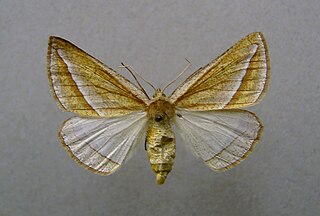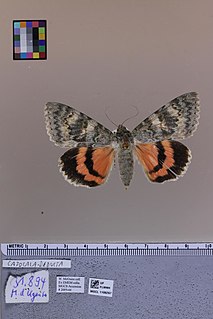
Alexander Eduard Friedrich Eversmann was a Prussian biologist and explorer.
Eversmann's hamster is a species of hamster in the family Cricetidae, and is one of two members of the genus Allocricetulus. It has been named after the Russian naturalist, zoologist, and explorer Eduard Friedrich Eversmann. It is endemic to Kazakhstan.

Arctia menetriesii, the Menetries' tiger moth, is a species of tiger moth in the family Erebidae. It was first described by Eduard Friedrich Eversmann in 1846. It is found in Karelia, Oktyabrskoe, northeastern Kazakhstan, Altai Mountains, Sayan Mountains, Evenkia, Yakutia, the central Amur region, Primorsky Krai and central Sakhalin. It was believed to be extinct in Fennoscandia, but the species has been recently recorded in Finland. This species is characterized by the fact that they never come to light; such behavior is atypical in the family Arctiidae.

Oeneis is a butterfly genus of the Satyrinae. All but one of its members are Arctic, sub-Arctic or high-altitude alpine in distribution. Some of the members of the genus are among the butterflies that can get along in the harshest climates of any butterflies. Four species in Europe, more are found in Arctic Russia, Siberia, Mongolia, Arctic North America and the Rocky Mountains. Curiously, there are no observations from Greenland. The development of most species takes two years.

Loxostege is a genus of moths of the family Crambidae.

Sclerocona is a genus of moths of the family Crambidae which contains only one species, Sclerocona acutella. It was first described by the Prussian biologist Eduard Friedrich Eversmann in 1842.

Chersotis is a genus of moths of the family Noctuidae.

Cucullia is a genus of moths of the family Noctuidae. The genus was erected by Franz von Paula Schrank in 1802.

Dichagyris is a genus of moths of the family Noctuidae. The former genera Loxagrotis, Pseudorichia, Pseudorthosia and Mesembragrotis are now considered subgenera of Dichagyris. From Greek dikha-gyris 'apart, asunder; double' + 'the finest meal or flour'; English pronunciation: /digh-kuh-JIGH-riss/, IPA [dɑj•kə'dʒɑj•ɹɪs].

Chariaspilates is a monotypic moth genus in the family Geometridae erected by Eugen Wehrli in 1953. Its only species, Chariaspilates formosaria, was first described by Eduard Friedrich Eversmann in 1837. It is found in swampy areas from Europe to Japan.

Semiothisa is a genus of moths in the family Geometridae. It was erected by Jacob Hübner in 1818.

Euxoa adumbrata, the sordid dart, is a moth of the family Noctuidae. The species was first described by Eduard Friedrich Eversmann in 1842. In North America it is found across northern Canada from Quebec to western Alaska, south to the northern parts of the United States, and in the mountains to Colorado. It is also found in Greenland, the coastal areas of Scandinavia and the Ural. It was recently recorded from Denmark, although this includes Euxoa lidia, which some authors regard to be a valid species.

Cochylimorpha is a genus of moths of the family Tortricidae.
Chelis glaphyra is a moth in the family Erebidae. It was described by Eduard Friedrich Eversmann in 1843. It is found in eastern Kazakhstan, Kyrgyzstan, the central Tien Shan and China (Xinjiang).

Catocala deducta is a moth in the family Erebidae first described by Eduard Friedrich Eversmann in 1843. It is found in Russia.













